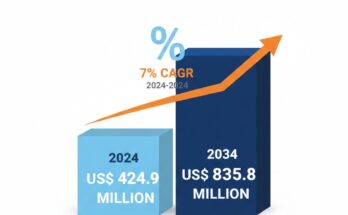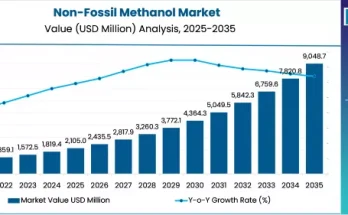Silicone release coatings play a crucial role in the global coatings industry, known for their exceptional non-stick performance, thermal stability, and resistance to chemicals. These properties make them essential in various high-demand applications such as pressure-sensitive labels, adhesive tapes, medical dressings, and hygiene products. Though often unnoticed by end-users, these coatings are fundamental to ensuring smooth functionality and reliability in both consumer and industrial settings.
As industries increasingly prioritize precision, efficiency, and sustainability, the demand for silicone release coatings continues to grow. Sectors like packaging, logistics, healthcare, and electronics are adopting these solutions to enhance product performance and meet environmental standards. The push toward eco-friendly formulations—especially solventless and UV-curable systems—is further driving innovation and investment across the market.
Market Dynamics & Growth Drivers
- Packaging & Logistics Boom
With e-commerce experiencing sustained growth, the need for efficient, fast-turn production in labels and release liners is intensifying. Silicone coatings ensure smooth label peeling, quick processing speeds, and long shelf life, supporting high-volume packaging operations.
- Medical & Hygiene Uptick
Healthcare and personal hygiene industries increasingly rely on silicone-coated materials for wound dressings, tapes, diapers, and more. These coatings provide critical attributes—biocompatibility, controlled adhesion, and gentle release—aligning with rising health standards and aging populations.
- Industrial Precision Needs
Electronics, automotive, and industrial processes demand silicone coatings for heat-resistant masking, adhesive tapes, and die-cut applications. Their thermal stability and chemical inertness make them suitable for cleanrooms and high-performance adhesive assemblies.
- Environmental Regulations
Stringent environmental regulations (such as EU’s REACH and US EPA controls) are driving a shift away from solvent-based systems toward greener solventless and UV-curable silicone coatings, reducing VOC emissions and improving energy efficiency.
Regional Overview
North America
Leading innovations in packaging and healthcare propel growth in the US, with major investments in solventless production lines and medical-grade coatings.
Europe
German, French, and Dutch manufacturers prioritize eco‑certified, UV-curable silicone solutions—boosted by regulatory frameworks and sustainable production targets.
Asia-Pacific
Asia-Pacific is the fastest-growing regional market. China, Japan, South Korea, and India are driving demand through massive e‑commerce, hygiene, and electronics sectors. Regional players are investing in clean technologies and production capacity.
Latin America & Middle East
These regions are emerging sectors, with opportunities in packaging and personal care, though limited by economic instability and supply chain constraints.
Market Segmentation
- By Release Force
- Medium-release coatings dominate due to their balance of adhesion and release, ideal for labels, tapes, and medical applications. They allow versatility across adhesives like acrylics, hot melts, and silicones.
- By Type
- Solvent-based systems remain common but face scrutiny.
- Solventless & UV-curable formulations are gaining traction due to low VOC emissions, fast curing, and alignment with sustainability trends.
- By End-Use
- Labels & Laminates lead in usage across consumer goods, logistics, pharmaceuticals, and food industries.
- Medical & Hygiene Liners—for diapers, sanitary products, wound dressings—are high-growth segments, particularly in Asia.
Market Size & Forecast
- Global outlook projects a robust growth trajectory, with the market set to expand from ~USD 851 million in 2025 to nearly USD 1.79 billion by 2035—a CAGR of approximately 7.7%.
- Historical growth includes a strong year-over-year increase of over 8% in 2021, reaching roughly USD 626 million.
- Segment outlook highlights hygiene liners growing at ~8.4% CAGR (2022–32), while medium-release and solventless coatings pave future growth.
Competitive Landscape
Major players are innovating through sustainable technologies, bespoke formulations, and strategic partnerships:
- Dow/Dow Corning introduced a carbon-neutral silicone release solution, SYL-OFF SL 184, targeting high-speed labeling at Labelexpo.
- Wacker Chemie launched the DEHESIVE eco series—low-VOC coatings for tapes and labels.
- Shin-Etsu reduced platinum catalyst usage in silicone formulations, improving cost-effectiveness.
- Other key companies: Momentive, Evonik, KCC Silicone, Elkem, Silibase, and PPG.
Opportunities & Challenges
⚠️ Challenges
- High raw material costs, including PDMS and platinum catalysts, inflate pricing, especially in cost-sensitive markets.
- Regulatory pressure on VOC emissions and recyclability complicates product formulation.
- Technical complexity—installing and managing UV/solventless lines requires skilled workforce and capital.
- Recycling issues, since coated liners can’t easily separate substrates—hindering sustainability goals.
🌱 Opportunities
- Innovation in solventless/UV systems meets eco standards and operational efficiency.
- Smart packaging—with RFID and sensors—spurs demand for advanced release liners.
- Emerging markets in Asia and Latin America offer high-growth potential.
- Hygiene applications are surging, with liners in demand for diapers, feminine hygiene, and medical dressings.
Future Outlook
- Wider adoption of solventless and UV-curable coatings as global regulations tighten.
- Growth in hygiene liners—spurred by lifestyle changes and urbanization.
- Advanced applications in electronics and automotive, particularly cleanroom masking and adhesive integration.
- Circular economy integration, addressing recyclability through improved liner designs.
- Strategic regional investments, especially in Asia-Pacific’s fast-paced markets.
Conclusion
The silicone release coatings sector is poised for robust and sustained growth, propelled by innovation, regulation, and surging demand across industries. As solventless and UV-curable technologies take center stage and hygiene applications flourish, market players must navigate cost, technical, and regulatory challenges. Those who invest in sustainable, high-performance solutions—and expand regionally—will lead the charge in shaping the future of release coatings.


